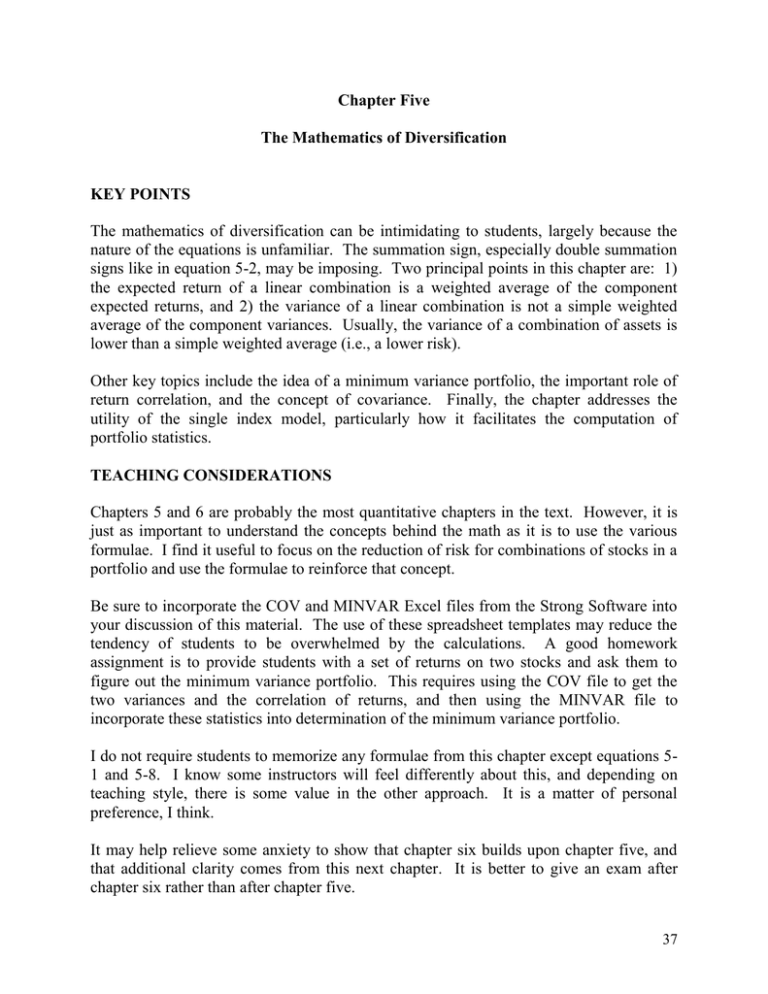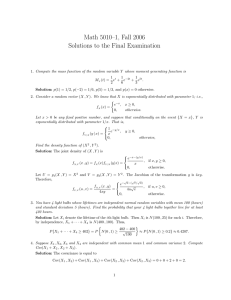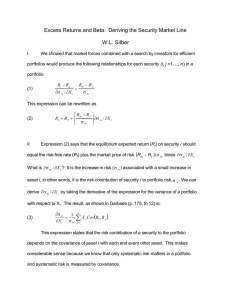
Chapter Five
The Mathematics of Diversification
KEY POINTS
The mathematics of diversification can be intimidating to students, largely because the
nature of the equations is unfamiliar. The summation sign, especially double summation
signs like in equation 5-2, may be imposing. Two principal points in this chapter are: 1)
the expected return of a linear combination is a weighted average of the component
expected returns, and 2) the variance of a linear combination is not a simple weighted
average of the component variances. Usually, the variance of a combination of assets is
lower than a simple weighted average (i.e., a lower risk).
Other key topics include the idea of a minimum variance portfolio, the important role of
return correlation, and the concept of covariance. Finally, the chapter addresses the
utility of the single index model, particularly how it facilitates the computation of
portfolio statistics.
TEACHING CONSIDERATIONS
Chapters 5 and 6 are probably the most quantitative chapters in the text. However, it is
just as important to understand the concepts behind the math as it is to use the various
formulae. I find it useful to focus on the reduction of risk for combinations of stocks in a
portfolio and use the formulae to reinforce that concept.
Be sure to incorporate the COV and MINVAR Excel files from the Strong Software into
your discussion of this material. The use of these spreadsheet templates may reduce the
tendency of students to be overwhelmed by the calculations. A good homework
assignment is to provide students with a set of returns on two stocks and ask them to
figure out the minimum variance portfolio. This requires using the COV file to get the
two variances and the correlation of returns, and then using the MINVAR file to
incorporate these statistics into determination of the minimum variance portfolio.
I do not require students to memorize any formulae from this chapter except equations 51 and 5-8. I know some instructors will feel differently about this, and depending on
teaching style, there is some value in the other approach. It is a matter of personal
preference, I think.
It may help relieve some anxiety to show that chapter six builds upon chapter five, and
that additional clarity comes from this next chapter. It is better to give an exam after
chapter six rather than after chapter five.
37
Chapter Five
The Mathematics of Diversification
ANSWERS TO QUESTIONS
1. Selling stock short brings cash in rather than requiring a cash outflow. In the absence
of margin requirements (which is arguably true for large institutional investors), this
means there is no initial investment, and any gain on no investment is an infinite
return.
2. Student response.
3. The two-security portfolio is preferable, as it has higher expected return per unit of
risk.
4. Covariance is the expected value of the product of two numbers. Each of the two
numbers is a value minus its mean. Some values lie below the mean, some above.
Consequently, each number can be positive or negative, and the product can therefore
be positive or negative. Depending on the nature of the dispersions around the means,
the expected value of the product can be positive or negative.
~
~
~
5. E[( a~ a )( b b )] cov( a~, b ) and E[( b b )( a~ a )] cov( b , a ) . By the commutative
law for multiplication, ab = ba. This means the order of the two products inside the
~
~
expected value operator can be reversed and cov( a~, b ) cov( b , a~ ).
6. a am a m
Where
am = correlation between security a and the market
a = standard deviation of security a
m = standard deviation of the market
7. 0.25 x (4).5 x (6).5= 1.225
8. The size of the error term approaches zero as the number of portfolio components
increases.
9. Standard deviations can only be positive, so a negative correlation means the
covariance is also negative.
10. In a prediction model, R squared can only increase if additional explanatory variables
are added. You cannot lose predictive ability by including additional data.
38
Chapter Five
The Mathematics of Diversification
ANSWERS TO PROBLEMS
1.
(n 2 n) 1700 2 1700
1,444,150
2
2
Note: The first printing of this book had errors in Table 5-5. The covariance values
should be as shown in the table below.
A
.280
.215
.136
.249
A
B
C
D
xa
2.
B
.215
.360
.170
.185
C
.136
.170
.203
.114
D
.149
.185
.114
.226
B2 A B AB
A2 B2 2 A B AB
.36 (.28) .5 (.36) .5 AB
.28 .36 2(.28) .5 (.36) .5 AB
AB
~ ~
cov( A, B )
A B
.215
0.677
(.28) .5 (.36) .5
.36 (.28) .5 (.36) .5 (.677)
xA
.28 .36 2(.28) .5 (.36) .5 (.677)
=
4
0.1450
= 69.2%
0.2101
1
4
3. p x1 i (1.05 + 1.20 + 0.90 + 0.95) = 1.025
i 1
4. 2p p2 m 2 ep2 . The error term approaches zero, so p2 (1.025) 2 (.25) 0.263.
5. xA = -.30 xB = .50
xC = .80
N
~
~
E ( R p ) x i E ( Ri )
i 1
= (-.30)(.14) + (.50)(.16) + (.80)(.12) = .1340 = 13.4%
39
Chapter Five
The Mathematics of Diversification
N
N
x i x j ij i j
2
p
i 1 j 1
x A2 A2 x B2 B2 xC2 C2 x A xC AC a C x A x B AB A B x B xC BC B C
= (-.3)2 (.28) + (.5)2 (.36) + (.8)2 (.203) + (-.3)(.8) AC (.28).5(.203).5 +
(-.3)(.5) AB (.28).5(.36).5 + (.5)(.8) BC (.36).5(.203).5
= .0252 + .09 + .1299 - .0572 AC - .0476 AB + .1081 BC
AB
AC
BC
~ ~
cov( A, B )
A B
.215
0.677
(.28) .5 (.36) .5
.136
0.570
(.28) .5 (.203) .5
.170
0.629
(.36) .5 (.203) .5
~ ~
cov( A, C )
A C
~ ~
cov( B , C )
B C
2p .0252 .09 .1299 .0572(.570) .0476(.677) .1081(.629) 0.2483
~ ~
6. cov(C, D) C D m2
= (0.90)(0.95)(.32) = 0.274
7. 2 25% .25
=(.25).5 = .5 = 50%
8. BC
9.
~ ~
cov( B , C )
B C
.170
= .629
(.36) .5 (.203) .5
cov(1,2) 1 2 m2
m2
40
cov(1,2)
1 2
1.55
1.127
(1.10)(1.25)
Chapter Five
The Mathematics of Diversification
10. See the computer printouts below.
ENTER UP TO 100 RETURNS FOR UP TO FIVE SECURITIES
IN LOTUS COLUMNS B, C, D, E, AND F
HIT ESC to enter data or ALT S for menu.
Return #
EXAMPLE
1
2
3
4
5
6
7
8
Sec 1
10.00%
0.0270
0.0120
-0.0220
0.0130
-0.0110
-0.0330
0.0290
0.0550
Sec 2
-8.00%
-0.0230
0.0000
-0.0100
0.0340
-0.0230
-0.0610
0.0260
0.0450
Sec 3
20.00%
0.0560
0.0130
-0.0150
0.0150
0.0120
-0.0350
0.0020
0.0470
Sec 4
10.00%
0.0020
0.0040
0.0020
0.0100
-0.0290
-0.0220
0.0000
0.0200
Sec 5
0.00%
0.0330
0.0170
-0.0450
0.0080
-0.0190
-0.0240
-0.0010
0.0560
Security
Statistics
Mean
std dev
variance
Sec 1
0.88%
0.02736
7.49E-04
Sec
Sec
Sec
Sec
Sec
1
2
3
4
5
Sec 1
7.49E-04
7.05E-04
6.28E-04
3.06E-04
7.53E-04
1
2
3
4
5
Sec 1
1.000
0.781
0.824
0.739
0.901
Sec
Sec
Sec
Sec
Sec
Sec 2
-0.15%
0.03301
1.09E-03
Sec 3
1.19%
0.02786
7.76E-04
COVARIANCE MATRIX
Sec 2
Sec 3
1.09E-03
4.43E-04
3.95E-04
5.49E-04
7.76E-04
2.25E-04
7.26E-04
CORRELATION MATRIX
Sec 2
Sec 3
1.000
0.481
0.792
0.545
Sec 4
-0.16%
0.01512
2.28E-04
Sec 5
0.31%
0.03054
9.33E-04
Sec 4
Sec 5
2.28E-04
2.95E-04
9.33E-04
Sec 4
1.000
0.534
0.853
1.000
0.640
Sec 5
1.000
~
E ( R p ) .30(-.15%) + .70(1.19%) = 0.788%
2p x22 22 x32 32 x2 x3 23 2 3
= (.3)2 (.0011) + (.7)2 (.0008) + (.3)(.7)(.481)(.03301)( .02786)
= 0.0006
41
Chapter Five
The Mathematics of Diversification
11. Because we have the entire set of data, we can simply compute each periodic
portfolio return and then determine the mean and variance of this series.
Security 1
Security 2
Security 3
Security 4
Security 5
0.0270
-0.0230
0.0560
0.0020
0.0330
0.0120
0.0000
0.0130
0.0040
0.0170
-0.0220
-0.0100
-0.0150
0.0020
-0.0450
0.0130
0.0340
0.0150
0.0100
0.0080
-0.0110
-0.0230
0.0120
-0.0290
-0.0190
-0.0330
-0.0610
-0.0350
-0.0220
-0.0240
0.0290
0.0260
0.0020
0.0000
-0.0010
0.0550
0.0450
0.0470
0.0200
0.0560
Portfolio
mean
Portfolio
variance
~
E ( R p ) 0.0041
Average
0.0190
0.0092
-0.0180
0.0160
-0.0140
-0.0350
0.0112
0.0446
0.0041
0.0005
p2 = 0.0005
12. The minimum variance combinations are as follows:
Pair
1,2
1,3
1,4
1,5
2,3
2,4
2,5
3,4
3,5
4,5
42
Proportion in the First
100%
98.72%
100%
100%
34%
100%
41.5%
0.61%
80.5%
100%
Proportion in the Second
0%
1.28%
0%
0%
66%
0%
58.5%
99.39%
19.5%
0%
Chapter Five
The Mathematics of Diversification
13. See the spreadsheet extracts below from the COV and MINVAR3 templates. The
minimum variance portfolio involves going short security 5 and buying securities 3
and 4.
ENTER UP TO 100 RETURNS FOR UP TO FIVE
SECURITIES
IN LOTUS COLUMNS B, C, D, E, AND F
Return #
EXAMPLE
1
2
3
4
5
6
7
8
Run the \S macro for the
main menu.
4
5
-8.00%
20.00%
10.00%
0.0020
0.0330
0.0040
0.0170
0.0020
-0.0450
0.0100
0.0080
-0.0290
-0.0190
-0.0220
-0.0240
0.0000
-0.0010
0.0200
0.0560
3
10.00%
0.0560
0.0130
-0.0150
0.0150
0.0120
-0.0350
0.0020
0.0470
Security Statistics
Mean
std dev
Variance
3
4
5
3
1.19%
0.02786
7.76E-04
3
1.000
0.534
0.853
4
-0.16%
0.01512
2.28E-04
5
0.31%
0.03054
9.33E-04
CORRELATION MATRIX
4
5
1.000
0.640
1.000
DETERMINING THE MINIMUM VARIANCE
THREE-SECURITY PORTFOLIO
Enter the INPUT in the boxes provided below:Variance of Stock A:
0.0008
(Standard deviation =
0.0279
Variance of Stock B:
0.0002
(Standard deviation =
0.0151
Variance of Stock C:
0.0009
(Standard deviation =
0.0305
Correlation between Stocks A and B:
0.5340
COV(A,B)=
0.0002
Correlation between Stocks B and C:
0.8530
COV(B,C)=
0.0004
Correlation between Stocks A and C:
0.6400
COV(A,C)=
0.0005
The Minimum Variance Combination is:
43
Chapter Five
The Mathematics of Diversification
14.65% <-Stock A
135.65% <-Stock B
-50.30% <-Stock C
With these proportions, Portfolio variance is :->
Portfolio standard deviation is :->
0.0001
0.0120
14. CFA Guideline Answer (reprinted with permission from the CFA Study Guide, CFA
Institute, Charlottesville, VA. All Rights Reserved).
A. Subscript OP refers to the original portfolio, ABC to the new stock, and NP to the
new portfolio.
i. The expected return is 0.728 percent.
E(rNP) = wOPE(rOP) + wABCE(rABC)
E(rNP) = 09 (.67) + 0.1 (1.25)
E(rNP) = 0.603 + 0.125 = 0.728%
ii. The expected covariance is 2.80.
COV = r (σOP) (σABC)
COV = 0.40 (2.37) (2.95) = 2.7966 or 2.80
iii. The expected standard deviation is 2.27 percent.
σNP = [ wOP2 σNP2 + wABC2 σABC2 + wOP wABC COV ]1/2
σNP = [ 0.92 (2.372) + 0.12 (2.952) + 2 (0.9) (0.1) (2.80) ]1/2
σNP = [4.5497 + 0.0870 + 0.5040]1/2 = 2.2673 or 2.27%
B. Subscript OP refers to the original portfolio, GS to government securities, and NP
to the new portfolio.
i. The expected return is 0.645 percent.
E(rNP) = wOPE(rOP) + wGSE(rGS)
E(rNP) = 09 (.67) + 0.1 (0.42)
E(rNP) = 0.603 + 0.042 = 0.645%
ii. The expected covariance is 0.
44
Chapter Five
The Mathematics of Diversification
COV = r (σOP) (σGS)
COV = 0 (2.37) (0) = 0
iii. The expected standard deviation is 2.13 percent.
σNP = [ wOP2 σNP2 + wGS2 σGS2 + wOP wGS COV ]1/2
σNP = [ 0.92 (2.372) + 0.12 (0) + 2 (0.9) (0.1) (0) ]1/2
σNP = [4.5497 + 0 + 0]1/2 = 2.133 or 2.13%
C. Adding the risk-free government securities would cause the beta of the new
portfolio to be lower. The new portfolio beta will be a weighted average of the
individual security betas in the portfolio; the presence of the risk-free securities
would lower that weighted average.
D. The comment is correct. Although the standard deviations and expected returns of
the two securities under consideration are the same, the covariances between each
security and the original portfolio are unknown, making it impossible to draw the
conclusion stated. For instance, if the covariances are different, selecting one
security over the other may result in a lower standard deviation for the portfolio as
a whole. In such a case, that security would be the preferred investment if all
other factors are equal.
E. i. Grace clearly expressed the sentiment that the risk of loss was more important
to her than the opportunity for return. Using variance (or standard deviation)
as a measure of risk in her case has a serious limitation because it does not
distinguish between positive and negative price movements.
ii. Two alternative risk measures that could be used instead of variance are:
Range of Returns, which considers the highest and lowest expected returns in
the future period, with a larger range being a sign of greater variability and
therefore of greater risk;
Semivariance, which can be used to measure expected deviations of returns
below the mean or some other benchmark, e.g., zero.
45
Chapter Five
The Mathematics of Diversification
Either measure would potentially be superior to variance for Grace. Range of
returns would help to highlight the full spectrum of risk she is assuming,
especially the downside portion of the range about which she is so concerned.
Semivariance would also be effective, because it implicitly assumes that the
investor wants to minimize the likelihood of returns falling below some target
rate; in Grace’s case, the target would be set at zero (to protect against negative
returns).
46




